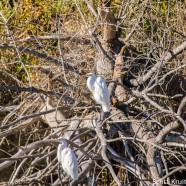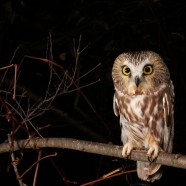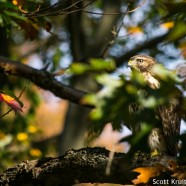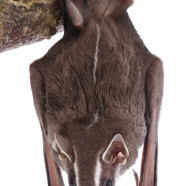Great Egret roost
What is this, November in Florida? Nope, I assure you it is New England. Here we have a distant shot featuring four of six Great Egrets that were present in a roost on a sunny November day in Connecticut. I did not want to disturb or flush them from this quiet, isolated area and stayed far away in cover. Waterbirds like this can tough it out in Connecticut thanks to our changing climate. As you can see quite literally it is not simply an aberrant bird or two. Scott Kruitbosch Conservation & Outreach Coordinator
Read MoreNorthern Saw-whet Owl movement continues
If you are anywhere in New England or the Mid-Atlantic it is a great time to be watching for Northern Saw-whet Owls (Aegolius acadicus). You will not likely find them like this as it is a photo RTPI Affiliate Sean Graesser took while netting and banding more of the species on the move through New Jersey. Nevertheless, you cannot win if you do not play! Take a look at any dense vegetation you come across as they are often near our eye level. They frequently choose evergreen trees to roost in and will stay buried between thick branches or near the trunk. Of course you can always rely on...
Read MoreJuvenile Red-shouldered Hawk (Buteo lineatus)
This juvenile Red-shouldered Hawk (Buteo lineatus) had landed only moments before I snapped this photo on Monday morning. Oak trees like this one, in contrast to the maple branch you can see, shed their leaves late in the autumn foliage season. As such they are an ideal spot for a young migrant like this one to stop on the way south while staying out of sight. I snapped a few photos of the bird while on the phone with RTPI’s Conservation Technician Elyse Henshaw. By the time we were off and I looked back it was already gone. Ships in the night… Scott Kruitbosch Conservation &...
Read MoreTent-making Bat (Uroderma bilobatum) by Twan Leenders
Here’s a Tent-making Bat (Uroderma bilobatum) that was photographed by Twan while in Costa Rica. These bats make nifty day-time roost sites in understory palms of the rainforest. They chew partway through the leaflets on a single frond, causing them to droop down and create a ‘tent’ of sorts. They like to make a large number of tents within their territory and change their roost site frequently so they don’t fall prey to sharp-eyed predators who may recognize the shape of their unique shelter. Tents that have not been used for a while often become a favored site for...
Read More







